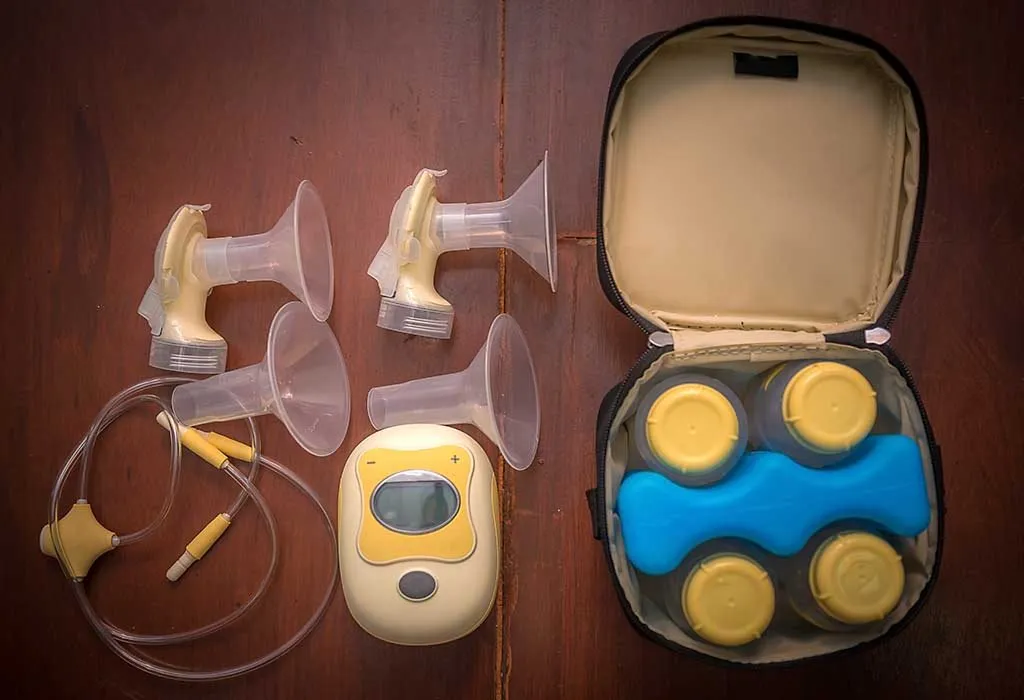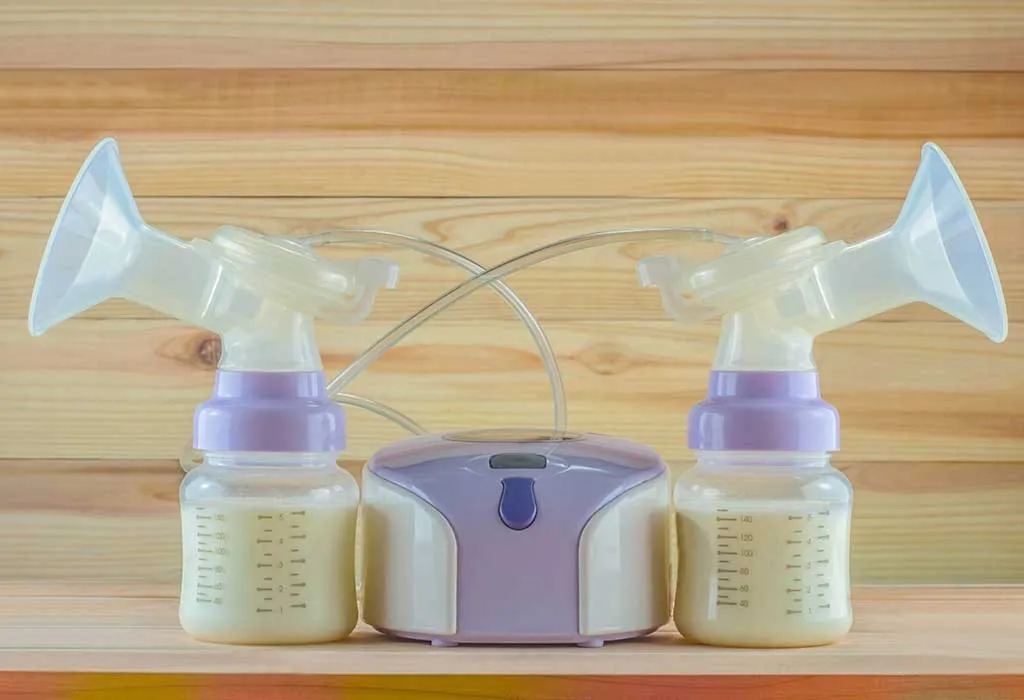Electric Breast Pumps – Pros, Cons and Tips to Use
- Is Electric Breast Pump Safe?
- When Can You Consider Using an Electric Breast Pump?
- Components of Electric Breast Pump
- Advantages of Using an Electric Breast Pump
- How to Use an Electric Breast Pump Safely?
- What Are the Side Effects of Using an Electrical Breast Pump?
- Things You Should Keep in Mind While Using an Electric Breast Pump
- FAQs
Breastfeeding is one of the most important aspects of motherhood. You can either breastfeed your baby normally, use a manual breast pump or electric breast pump or combine all the techniques. Electric breast pumps have become an essential tool for many breastfeeding mothers, offering a convenient and efficient way to express milk. Whether returning to work, managing a busy schedule, or simply seeking to increase milk supply, these devices provide a versatile solution. However, as with any technology, they come with their own set of advantages and drawbacks. In this article, we will learn about electric breast pumps, their advantages and disadvantages, and ways to use them safely. We will also answer some of the frequently asked questions.
Is Electric Breast Pump Safe?
Yes, electric breast pumps are generally safe when used according to the manufacturer’s instructions. They are designed to mimic the natural sucking action of a baby, helping mothers express milk efficiently and comfortably.
When Can You Consider Using an Electric Breast Pump?
When to use an electric breast pump can depend on various personal and practical factors. Let us understand who should use an electric breast pump.
1. Moms Who May Deliver Early
Women who have complications in their pregnancy or are at high risk of delivering early would do well to use an electric pump since a low-weight preterm baby may be too weak to suckle.
2. Mothers Who Are Working
Most moms take a few months of maternity leave after delivery. However, a few may have to start working immediately after their delivery. Such mothers need to express their milk for the entire day’s feed.
3. Mothers Having Twin Babies
For mothers with twins, breastfeeding can be extremely tiring. Therefore, mothers with twin babies can express more milk in less time with electric breast pumps.
4. Moms With a Lot of Milk Supply
For mothers who eject more milk than required, the relief of being able to express their milk and feed their baby later with the expressed milk can be significant.
5. Moms With Less Time to Express Milk
For mothers with busy work schedules and less time to express their milk, the necessity of depending on electric breast pumps is clear, as it provides a practical solution to their time constraints.

Components of Electric Breast Pump
Electric breast pumps have several key components that work together to provide an efficient and comfortable pumping experience. Here are the primary parts of an electric breast pump:
1. Motor Unit
The motor unit is the powerhouse of the electric breast pump, providing the suction needed to extract milk from the breast. It typically has adjustable settings to control suction strength and speed.
2. Breast Shields
Breast shields, also known as flanges, are the parts that directly contact the breast. They come in various sizes to ensure a proper fit and maximise comfort and milk flow.
3. Milk Collection Bottles
These containers attach to the breast shields and collect the expressed milk. They are usually made of BPA-free plastic or glass and often come with lids for storage.
4. Tubing
The tubing connects the breast shields to the motor unit, transferring the suction from the motor to the breast. Keeping the tubing clean and free from moisture is essential to prevent mould growth.
5. Valves and Membranes
Valves and membranes are small parts that play a crucial role in creating suction and ensuring the efficient flow of milk into the collection bottles. They need to be cleaned and replaced regularly for optimal performance.
6. Power Adapter or Battery Pack
Electric breast pumps can be powered by a power adapter plugged into an outlet or battery pack for more portable use. Some models offer both options for greater convenience.
7. Control Panel
The control panel is where you can adjust the pump’s settings, such as suction strength and speed. It may include digital displays and buttons for ease of use.

Advantages of Using an Electric Breast Pump
Due to the various benefits of electric breast pumps, more and more mothers are using them; some of the key benefits are (1):
- An electric breast pump may prove to be a boon for mothers with limited time. An electric breast pump requires less time to express milk effectively than a manual one.
- Since it comes with double breast pumps, it can simultaneously pump out milk, thus saving you time.
- Moms who need to pump out milk regularly or daily can do so with little effort.
- An electric breast pump offers different types of models, like double and hospital-grade pumps.
- Electric breast pumps are easy to clean and sanitise. They also come with microwavable steam bags and wipes.

How to Use an Electric Breast Pump Safely?
Using an electric breast pump safely involves understanding the correct techniques and proper hygiene. Here are essential tips to help you do so.
1. Read the Manufacturer’s Instructions
Before using your pump, thoroughly read the manual to understand the correct setup and usage procedures. This will help prevent any misuse and potential damage.
2. Wash Your Hands and Clean the Pump Parts
Always wash your hands before handling the pump or your breasts. Clean all pump parts that come into contact with breast milk after each use to maintain hygiene and prevent infections (3).
3. Ensure Proper Fit of Breast Shields
Ensure the breast shields fit correctly to avoid discomfort and ensure efficient milk extraction. Consult the manual or a lactation consultant to find the right size.
4. Start With a Low Suction Setting
Begin pumping with a low suction setting and gradually increase it to a comfortable level. High suction levels right away can cause pain and damage to breast tissue (6).
5. Maintain a Comfortable Position
Sit in a comfortable and relaxed position while pumping. If needed, use a pillow for support. Ensure that the pump is at a comfortable height to avoid straining your back or shoulders.
6. Store Milk Safely
After pumping, store the expressed milk in clean, sterilised containers and refrigerate or freeze it promptly. Label the containers with the date to keep track of freshness (5).

What Are the Side Effects of Using an Electrical Breast Pump?
While electric breast pumps offer numerous benefits, it’s important to be aware of potential side effects. Listed below are few of the disadvantages of an electrical breast pump (2).
- Giving expressed milk to your baby in feeding bottles can result in your baby not getting exposure to your nipples, and he may not recognise them when introduced.
- Expressed milk through a pump may be contaminated and cause severe health hazards to the baby.
- The incorrect size of the flanges may cause damage to the nipples or if the pump speed is too high or too slow.
- Storing excess milk for later use can cause more milk production, causing breast engorgement.
- The cleaning and sanitisation process after the pump is used takes a lot of time and energy.
Things You Should Keep in Mind While Using an Electric Breast Pump
Several important considerations can enhance your experience and ensure optimal results when using an electric breast pump. Listed below are some key factors that can help you make the most of your pumping sessions while maintaining comfort and efficiency.
1. Double Pumps
Models with double pumps can pump milk from both breasts simultaneously, which saves time and increases milk production since the more milk is pumped out, the more milk is generated.
2. Electric Pumps Which Are Easy to Use, Clean and Assemble
Choose a pump that can easily be cleaned and sanitised after use. Moreover, an electric model with better vacuum pumps will make it easier to grip the breasts for smooth milk suction. Also, a model that is easy and quick to assemble will always be a good buy.
3. The Speed of the Pump
Look for electric breast pumps that pump out more milk in less time. A good quality one will change the speed with the touch of a button.
4. Pumping Outside
If you are a mom who has to go out often or has to go to work, choose a pump that is portable and can easily be carried around. Many come with ice bags to store the expressed milk or chargers that can be attached to the plug point in the car.
FAQs
1. Electric breast pump or manual – Which one is better?
Each type of pump may have its own pros and cons. The user should decide what her priorities are and use one accordingly.
For a mother who cannot spend much time expressing milk, an electrical pump is the safest bet, though it may be a lot more expensive than manual pumps. Manual pumps are portable and can be carried around easily inside a handbag, while it may be a bit difficult to carry an electric pump outside the house (4).
2. What are double electric breast pumps?
A double electric pump is one in which two pumps can be used to pump milk simultaneously (7).
3. How often should I use an electric breast pump?
The frequency of using an electric breast pump depends on your breastfeeding goals. Aim to pump every 2-3 hours for exclusive pumping to mimic a baby’s feeding schedule. You might pump less frequently if you’re pumping to build a stash or for occasional bottle feeding. Always follow a schedule that works best for you and your baby.
Electric breast pumps offer a versatile and convenient solution for breastfeeding mothers, balancing the demands of modern life with the desire to provide breast milk. We hope this article answers your question, “Is an electric breast pump safe?” It can be a valuable tool in supporting a successful breastfeeding journey, providing flexibility and peace of mind. Invest in an electric breast pump and be content that your baby is getting your breast milk even when you are at work or away.
References/Resources:
1. Buckley. K. M; A double-edged sword: lactation consultants’ perceptions of the impact of breast pumps on the practice of breastfeeding; PubMed Central; https://www.ncbi.nlm.nih.gov/pmc/articles/PMC2684034/#
2. Leiter. V, Agiliga. A, Kennedy. E, Mecham. E; Pay at the pump?: Problems with electric breast pumps; Social Science & Medicine; https://www.sciencedirect.com/science/article/abs/pii/S0277953621009576
3. What to Know When Buying or Using a Breast Pump; U.S. Food and Drug Administration; https://www.fda.gov/consumers/consumer-updates/what-know-when-buying-or-using-breast-pump
4. Expressing with a pump; NHS; https://www.nhs.uk/start-for-life/baby/feeding-your-baby/breastfeeding/expressing-your-breast-milk/expressing-breast-milk-with-a-pump/
5. Breast Milk for Your Hospitalized Infant: Electric Breast Pump; Nationwide Children’s; https://www.nationwidechildrens.org/family-resources-education/health-wellness-and-safety-resources/helping-hands/breast-milk-for-your-hospitalized-infant-electric-breast-pump
6. USING A BREAST PUMP; The Royal Women’s Hospital; https://www.thewomens.org.au/images/uploads/fact-sheets/Using-a-breast-pump-060219.pdf
7. Morgan. J; 5 things to know about buying and using breast pumps; The University of Texas Southwestern Medical Center; https://utswmed.org/medblog/breast-pumps/
Also Read:
Power Pumping to Increase Milk Supply
How to Pump and Store Breast Milk?
How to Hand Express Breast Milk?
Breastfeeding Pump Side Effects & How to Avoid?
Was This Article Helpful?
Parenting is a huge responsibility, for you as a caregiver, but also for us as a parenting content platform. We understand that and take our responsibility of creating credible content seriously. FirstCry Parenting articles are written and published only after extensive research using factually sound references to deliver quality content that is accurate, validated by experts, and completely reliable. To understand how we go about creating content that is credible, read our editorial policy here.























